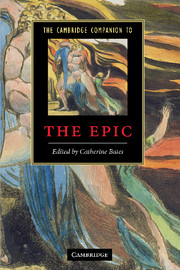Book contents
- Frontmatter
- 1 The Epic of Gilgamesh
- 2 Greek epic
- 3 Roman epic
- 4 Heroic epic poetry in the Middle Ages
- 5 Dante and the epic of transcendence
- 6 Italian Renaissance epic
- 7 Camões’s Os Lusíadas: the first modern epic
- 8 The Faerie Queene: Britain’s national monument
- 9 The seventeenth-century Protestant English epic
- 10 Mock-heroic and English poetry
- 11 Romantic re-appropriations of the epic
- 12 Ezra Pound, T.S. Eliot, and the modern epic
- 13 Derek Walcott’s Omeros
- 14 Epic in translation
- Guide to further reading
- Index
8 - The Faerie Queene: Britain’s national monument
Published online by Cambridge University Press: 28 May 2010
- Frontmatter
- 1 The Epic of Gilgamesh
- 2 Greek epic
- 3 Roman epic
- 4 Heroic epic poetry in the Middle Ages
- 5 Dante and the epic of transcendence
- 6 Italian Renaissance epic
- 7 Camões’s Os Lusíadas: the first modern epic
- 8 The Faerie Queene: Britain’s national monument
- 9 The seventeenth-century Protestant English epic
- 10 Mock-heroic and English poetry
- 11 Romantic re-appropriations of the epic
- 12 Ezra Pound, T.S. Eliot, and the modern epic
- 13 Derek Walcott’s Omeros
- 14 Epic in translation
- Guide to further reading
- Index
Summary
In Book II, canto x of The Faerie Queene, Prince Arthur and Sir Guyon - heroes of the poem and Book respectively - settle down to a lengthy sojourn in one of the chambers of Alma's castle. Unusually for The Faerie Queene, however (and, indeed, for the epic tradition more generally), this indulgence is not coded as negative, as the kind of regressive, erotic deviance that typically holds the hero back or delays the successful achievement of his quest. On the contrary, although the two knights are said to be 'burning both with feruent fire' (II.IX.60), the activity that engages them is presented as a wholly legitimate pleasure - the 'naturall desire of countreys state' (II.X.77) - and as a necessary preparation for, if not condition of, their future success. As they immerse themselves in reading the history of their native lands - Arthur, in a book called Briton moniments, Guyon, in a volume entitled Antiquitie of Faerie lond - they learn the dynastic trajectory of their two nations, a trajectory that in both cases culminates in the present moment if not directly in themselves (Arthur's text tells the story of Britain from the Bronze Age up to the reign of his own father, Uther Pendragon; Guyon's, the story of the Faerie dynasty up to 'the fairest Tanaquill', II.X.76, that is, the Faerie Queene whom he serves and whose image he bears on his shield).
- Type
- Chapter
- Information
- The Cambridge Companion to the Epic , pp. 133 - 145Publisher: Cambridge University PressPrint publication year: 2010
- 3
- Cited by



